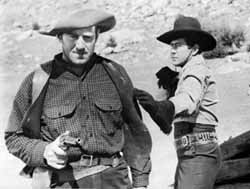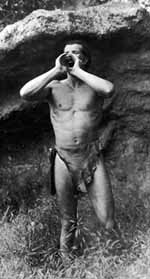|
Silent serials were initially dominated by heroines, but by the '20s, male stars such as Joe Bonomo, Francis Ford, William Desmond, and Walter Miller took the spotlight. Even Harry Houdini, Red Grange, and Jack Dempsey starred in serials, but by the end of the '20s the serial was virtually dead—a victim of oversaturation and the increasing sophistication of its audience. When the serials originated, they attracted a largely adult audience, but as the feature film slowly evolved, the serial failed to mature.
With the adult audience largely gone—and with the coming of sound to film—serial makers floundered. The serial seemed headed for extinction. Several independent companies produced serials in the early '30s but most productions were static and failed to grab a large audience.

Johnny Mack Brown prepares to punch out Roy Barcroft
in Flaming Frontiers.
Westerns reigned as the most popular genre of serials during this period. Westerns weren't affected by the transition to sound. In fact the sound of horse hooves, rifle fire, and Indian war cries only improved westerns. Buck Jones was one of the best western heroes. He starred in several serials, such as The Red Rider (1934), Roaring West (1935), and The Phantom Rider (1936). Jones gave his characters a quiet strength similar to William S. Hart. Other western serial heroes included Johnny Mack Brown, Tim McCoy, Harry Carey, Tom Mix, and Ken Maynard. After Johnny Mack Brown starred in a big budget feature, Billy the Kid (1930), that failed dramatically at the box office, he turned to serials. Some of his best efforts included Fighting With Kit Carson (1933), Rustlers of Red Dog (1935), Flaming Frontiers (1938), and The Oregon Trail (1939).
Likewise, John Wayne's first feature film, The Big Trail (1930), bombed at the box office, leaving Wayne to continue his career in B westerns and serials. None of Wayne's serials placed him in the West, but they weren't short on adventure. The Hurricane Express (1932) found him battling an arsonist bent on destroying a railroad company. Shadow of the Eagle (1932) placed him in a carnival. And The Three Musketeers (1933) found him in the Foreign Legion.
During this time period, aviation serials and jungle serials were also popular. Among the leading aviation serials, The Phantom of the Air (Universal, 1932) starred Tom Tyler and Mystery Squadron (1933) starred Bob Steele. In 1934, Universal delivered Tailspin Tommy, the first serial based on a comic strip. Soon afterwards, Universal delivered Ace Drummond (1936), based on a Sunday comic feature with stories attributed to Captain Eddie Rickenbacker, a famous WWI fighter pilot who shot down 26 German planes.

Herman Brix practices his yell
in The New Adventures of Tarzan.
Tarzan appeared in two serials in the early '30s. The first, Tarzan the Fearless (1933), was Buster Crabbe's first serial. And in 1934, Edgar Rice Burroughs decided to bring his own version of Tarzan to the movie screen. Disappointed with Hollywood's version of Lord Greystoke in the barely articulate persona of Johnny Weissmuller, Burroughs formed his own movie company and sent it to the jungles of Guatemala to film The New Adventures of Tarzan, with Olympic medalist Herman Brix starring. Filmed under some of the worst conditions imaginable with several members of the film crew succumbing to malaria and other diseases, the serial contains a rousing opening chapter and then promptly peters out, with scratchy audio, murky images, and hopelessly repetitive chases through the underbrush and long-lost Mayan cities. Other jungle serials soon followed with wild animal trainer Clyde Beatty in The Lost Jungle (1934) and Darkest Africa (1936) and Frank "Bring 'Em Back Alive" Buck in The Jungle Menace (1937).
Rounding out this early period, Mascot provided one of the most influential serials, The Phantom Empire (1936). This serial contained a little bit of everything on the Mascot lot--singing cowboys with a radio show, a kid's club of junior cowboys (who wore buckets on their heads and capes on their backs), and a scientifically-advanced civilization over 20,000 feet below ground. And it starred Gene Autry in his first movie role. Released over a year before Flash Gordon, The Phantom Empire paved the way for the deluge of science-fiction serials that were soon to follow. Republic cranked out two variations on the same story, giving us The Phantom Empire in a jungle--Darkest Africa--and The Phantom Empire undersea--Undersea Kingdom. All these serials gave us technologically advanced civilizations that still used swords and dressed like outcasts from Ancient Rome. But the stage was set for the next development--a development that would forever change the history of serials.
page 2 of 5
 
The Serials: An Introduction
Page 1: In the Theaters
Page 2: The Beginnings
Page 3: Enter Flash Gordon
Page 4: The Golden Age
Page 5: The Downfall
The Phantom Empire
Flash Gordon
Dick Tracy
The Fighting Devil Dogs
Zorro's Fighting Legion
The Shadow
Mysterious Dr. Satan
Spy Smasher
Perils of Nyoka
The Tiger Woman
Serials Web Links
|





